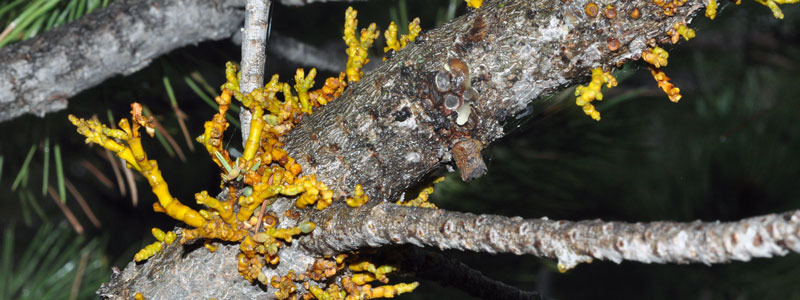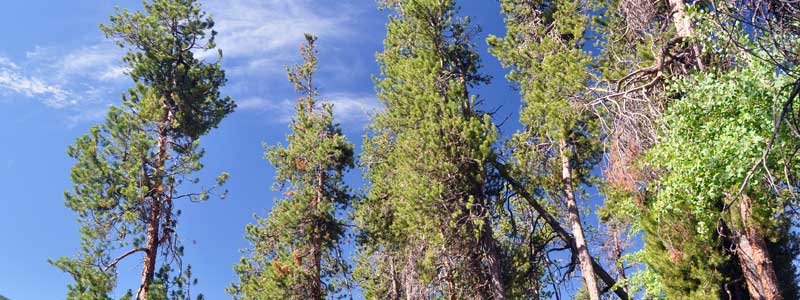Dwarf Mistletoe
Dwarf mistletoes are parasites of native conifer forests that can cause severe damage.



Dwarf Mistletoe: Parasitic Plants
Forty-two species of dwarf mistletoe are known worldwide; five species are found in Colorado’s forests. Most dwarf mistletoes are native to western North America, from Alaska south through the western United States, Mexico and Central America.
Dwarf mistletoe, a common problem in Colorado forests, predominantly affects ponderosa and lodgepole pines, although they can attack Douglas-fir, piñon, limber and bristlecone pines.
Dwarf mistletoes are parasites of native conifer forests that can cause severe damage. These plants tend to confine their attacks to one species of tree, with only occasional attacks on other species.
Dwarf mistletoe infections can retard growth and reduce seed production and wood quality; heavy, long-term infections can kill trees.
Some dwarf mistletoe species induce abnormal tree growth at the point of infection, and produce a structure known as a witches’ broom, which disrupts the typical branching structure.
Dwarf mistletoes are small, leafless parasitic flowering plants that kill by slowly robbing the tree of food and water.
Symptoms of Infestation
The first symptom of dwarf mistletoe infection is a slight swelling of the bark at the infection site. The parasite is identifiable when the yellow to green or brownish-green segmented shoots protrude from the infected part of the tree, which form about 2-3 years after the infection. Because dwarf mistletoes are slow killers, long-term management options are feasible.
Dwarf Mistletoe Species of Colorado’s Forests
| Dwarf Mistletoe Species | Lodgepole Pine Dwarf Mistletoe Arceuthobium americanum |
Douglas-Fir Dwarf Mistletoe Arceuthobium douglasii |
Southwestern Dwarf Mistletoe Arceuthobium vaginatum cryptopodum |
Limber Pine Dwarf Mistletoe Arceuthobium cyanocarpum |
Piñon Dwarf Mistletoe Arceuthobium divaricatum |
| Range in Colorado | Widespread; roughly 50% of lodgepole pine in Colorado have some degree of infection | Southwestern Colorado and the Western Slope | Spotty distribution throughout host range in Colorado | Rocky Mountain range throughout Colorado, primarily along the Front Range | Throughout host range in Four Corners region and western Colorado |
| Primary Host Species | Lodgepole pine | Douglas-fir | Ponderosa pine | Limber pine; Rocky Mountain bristlecone pine | Piñon pine |
| Plant Characteristics | Olive-green to yellow, 2-4 inches long | Olive-green, less than 1 inch long | Orange, reddish-brown to black, 4-6 inches long | Yellow-green, 1-3 inches long | Olive-green to brown, 3-5 inches long |
| Host Response | Conspicuous witches’ brooms, heavily infested crowns appear thin | Fan-shaped and spherical witches’ brooms | Small but conspicuous brooms on branches | Small and compact witches’ brooms | Small and compact witches’ brooms |
| Impact | Infestations can significantly reduce growth by 80-90% and predispose trees to other insects and diseases | Witches’ brooms may weigh in excess of several hundred pounds and cause severely swollen branches | Reduced growth, foliage discoloration and dieback reduce vigor of host tree | Considered second most important disease of high-elevation five-needle pines, causing severe mortality | Can cause increased mortality of piñon pines and significant deformation of host |
Source: 2010 Report on the Health of Colorado’s Forests
Management Options
- Pruning and removing infected trees is the best management measure available to reduce or eliminate dwarf mistletoe infestations.
- Plant resistant trees under infected ones to replenish the forest after infected ones are removed.
- If planting the same species as the infected tree, use approved sprays to reduce the risk of infestation. (Always carefully read and follow all label instructions before applying insecticides.)
Learn More About Dwarf Mistletoe
- Dwarf Mistletoe Poster (239 KB PDF)
- Dwarf Mistletoe Management
Annual Insect Activity
CSFS Forest Entomologist Dr. Dan West produces an Esri Story Map for the Annual Forest Health Report, which offers users an interactive way to find out about forest conditions and insect activity in their area.

